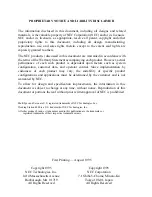
9.4.2. Battery charge voltages too high
If the battery charge voltages are set too high this will cause the batteries to overcharge.
Check if all the battery charge voltages (absorption and float) are set correctly.
The charge voltages have to match the recommended voltages as stated in the battery manufacturers documentation.
9.4.3. Battery unable to deal with equalization
During equalization the battery charge voltage will be quite high and if the battery is unsuitable to be equalized, the battery will be
overcharged.
Not all batteries can be charged with equalization voltages. Check with the battery manufacturer if the battery you are using
needs a periodic equalizing charge.
Generally speaking, sealed batteries and lithium batteries cannot be equalized.
9.4.4. Battery old or faulty
A battery that is at the end of its service life or has been damaged by incorrect use, can be prone to being overcharged.
A battery contains a number of cells that are connected in series. When a battery is old or has been damaged, a likely scenario is
that one of these cells is not operational anymore.
When the faulty battery is charged, the damaged cell will not accept charge and the remaining cells will receive the broken cell’s
charge voltage and thus will be overcharged.
To fix this, replace the battery. In case of multiple battery system replace the whole battery bank. It is not recommended to mix
batteries of different ages in one battery bank.
It is hard to tell what has exactly happened to a battery during its lifetime. The solar charger will keep 30 day of battery voltage
history. If the system also contains a battery monitor, or if the system is connected to VRM, the battery voltages and the cycle
history of the battery can be accessed This will give a complete picture of the battery history and it can be determined if the
battery is near the end of its service life or has been abused.
VictronConnect App showing BMV battery monitor history
To check if the battery is close to its cycle life:
1.
Find out how many charge and discharge cycles the battery has been subjected to. Battery lifetime correlates to the number
of cycles.
2.
Check how deep the battery has been discharge on average. A battery will last for less cycles if deeply discharged,
compared to more cycles if discharged less deep.
3.
Refer to the battery data sheet to find out how many cycles at what average discharge the battery is capable of. Compare
this with the battery history and determine if the battery is near the end of its service live.
To check if the battery has been misused:
1.
Check if the battery has been totally discharged at all. Total and very deep discharge will damage a battery. Check the battery
monitor setting history on the VRM portal. Look for the deepest discharge, the lowest battery voltage and the number of full
discharges.
MPPT solar charger manual
Page 50
Troubleshooting and Support
















































